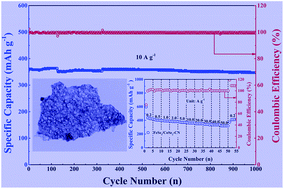Constructing electronic interconnected bimetallic selenide-filled porous carbon nanosheets for stable and highly efficient sodium-ion half/full batteries†
Abstract
Owing to their large theoretical capacity and relatively high electronic conductivity, transition metal selenides have been investigated as potential anodes for energy storage applications. On the other hand, the quick capacity decline induced by volume expansion during cycling and unconnected conducting network of the transition metal selenide-based electrode severely limit their employment in sodium-ion batteries (SIBs). Herein, a simple solvent ultrasonic technique and pyrolysis selenation process were used to make a porous N-doped carbon nanosheet-supported FeSe2/CoSe2 electrode. The electrochemical kinetics could be improved, and the stress generated by volume expansion could be efficiently adjusted by exquisitely constructed boundary of the FeSe2/CoSe2-CN electrode. As expected, the FeSe2/CoSe2-CN porous nanosheets exhibited a high Na+ storage capacity of 350 mA h g−1 (10 A g−1, 1000 cycles). Kinetic studies were conducted to explore the Na+ storage mechanism of FeSe2/CoSe2-CN. The as-constructed full sodium-ion batteries, when combined with Na3V2(PO4)2O2F, have a phenomenal energy density (109 W h kg−1), encouraging the exploration of energy-related components with the high-energy density properties.



 Please wait while we load your content...
Please wait while we load your content...